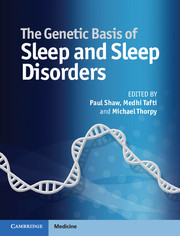
-
Select format
-
- Publisher:
- Cambridge University Press
- Publication date:
- 05 November 2013
- 24 October 2013
- ISBN:
- 9781139649469
- 9781107041257
- Dimensions:
- (246 x 189 mm)
- Weight & Pages:
- 1.1kg, 413 Pages
- Dimensions:
- Weight & Pages:
You may already have access via personal or institutional login
Book description
The first comprehensive book on the subject, The Genetic Basis of Sleep and Sleep Disorders covers detailed reviews of the general principles of genetics and genetic techniques in the study of sleep and sleep disorders. The book contains sections on the genetics of circadian rhythms, of normal sleep and wake states and of sleep homeostasis. There are also sections discussing the role of genetics in the understanding of insomnias, hypersomnias including narcolepsy, parasomnias and sleep-related movement disorders. The final chapter highlights the use of gene therapy in sleep disorders. Written by genetic experts and sleep specialists from around the world, the book is up to date and geared specifically to the needs of both researchers and clinicians with an interest in sleep medicine. This book will be an invaluable resource for sleep specialists, neurologists, geneticists, psychiatrists and psychologists.
Contents
Metrics
Altmetric attention score
Full text views
Full text views help Loading metrics...
Loading metrics...
* Views captured on Cambridge Core between #date#. This data will be updated every 24 hours.
Usage data cannot currently be displayed.
Accessibility standard: Unknown
Why this information is here
This section outlines the accessibility features of this content - including support for screen readers, full keyboard navigation and high-contrast display options. This may not be relevant for you.
Accessibility Information
Accessibility compliance for the PDF of this book is currently unknown and may be updated in the future.


